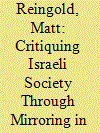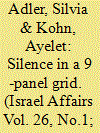| Srl | Item |
| 1 |
ID:
174373


|
|
|
|
|
| Summary/Abstract |
Seven of Israeli cartoonist Asaf Hanuka’s comic strips from his weekly series The Realist make use montage-like elements by juxtaposing distorted mirror images of scenes. While published over the course of Hanuka’s almost 10-year run and addressing radically different topics, the structure and nature of the seven strips is remarkably similar. Each includes the juxtaposition of contrasting ideas to offer a commentary on a different aspect of the Israeli society. These topics include the historical mistreatment of Jewish immigrants to the country, the country’s policies toward foreign workers, and the economic challenges faced by the middle-class Israelis. While Hanuka’s technique provides an opportunity for considering different attitudes toward the topic, these strips consistently take a stance that places blame on Israelis themselves for either their attitudes or their electoral decisions. The comics serve, therefore, as political commentary which through the juxtaposition of images, encourages societal change.
|
|
|
|
|
|
|
|
|
|
|
|
|
|
|
|
| 2 |
ID:
174026


|
|
|
|
|
| Summary/Abstract |
Asaf Hanuka’s autobiographical comic strips collected into one album, The Realist, chronicle everyday episodes in the life of a young Israeli family. The silent nature of many of the panels brings forth the gap between the idea and the praxis. We investigate silence in relation to both genre and Israeliness in order to examine what silence promotes and to what extent it serves the narrative better than sound or words when generating criticism, displaying helplessness, coping with traumatic events, etc. Our six case studies are conducted in the framework of both silence theories and multimodal discourse theories.
|
|
|
|
|
|
|
|
|
|
|
|
|
|
|
|